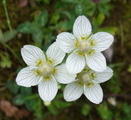530101 Parnassia palustris L.
- L., Sp. Pl.: 273 (1753). Lectotype (UPS): Europe. Herb. Burser XVII:91 (Hultgård 1987: 111).
Geography: Circumboreal-polar.
Notes: Elven and Murray: Parnassia palustris has a geographically structured morphological variation and two main ploidy levels with some correlation with morphology. Previous treatments are divergent with 1-3 taxa proposed and different circumscriptions of these. We accept the main variation as two races - subsp. palustris and subsp. neogaea - but there may be some additional, low-level variation within or close to subsp. palustris.
Four ploidy levels are known (2x, 3x, 4x, 6x). Diploids are widespread throughout the range in North America, Asia, and in Europe north to Denmark, southern Sweden, and southeastern Norway. Tetraploids predominate in the northern and central parts of Fennoscandia, northern European Russia, and are also reported with one count from northern Siberia and one dubious count from northern Canada, see below. Triploids and hexaploids are found rarely and only within the range of overlap of diploids and tetraploids in northwestern Europe.
Löve and Löve (1975a) divided P. palustris s. lat. on three taxa: the diploid P. palustris s. str., with subsp. palustris from Europe through Siberia to Alaska and subsp. neogaea from Alaska to eastern Canada, and the tetraploid P. obtusiflora from northwestern Europe to the Russian Far East. This treatment was based in their confidence in ploidy levels separating among species. A consistent division of the European diploids and tetraploids on two species is contrary to the currently known morphological and genetic pattern.
The plants of northern Europe are divisible on three groups when combining morphology and cytology: (A) Tall-grown and large-flowered diploids (P. palustris subsp. palustris sensu Löve and type) are temperate plants that do not reach even the boreal parts. (B) Morphologically seemingly inseparable tetraploids are common throughout and reach the Arctic. The Löves assigned these to P. obtusiflora. (C) Low-grown and small-flowered tetraploids occur in the mountains and to the north in northwestern Europe and European Russia. These correspond to var. tenuis Wahlenb. Plants of group (C) differ from those of groups (A-B) also in some other features, e.g., shape of leaves, position of the stem leaf, and shape of petals. Morphologically, the tetraploid var. tenuis could possibly be justified as a taxon but excluding the large-flowered tetraploids.
The northeastern Asian and North American subsp. neogaea is diploid, as also stated by Löve and Löve (1975a), and diploid numbers have been counted both in arctic-alpine and boreal North American plants and in Chukotkan ones. We have not seen any morphological parallel to the northern European var. tenuis among North American or Chukotkan plants. Fernald (1937) reported the following diagnostic characters for subsp. neogaea vs. subsp. palustris, with our comments in brackets: cauline leaf deltoid-ovate and subacute vs. rounded-ovate not separating very well; calyx lobes subherbaceous, linear-lanceolate to lanceolate-oblong, 2/3 length of capsule, and less divergent vs. firm, oblong-elliptic, mostly less than 1/2 length of capsule, and more divergent to reflexed partly separating; petals rhombic-elliptic, tapering to base and apex vs. emarginate, with coarse teeth or rounded partly separating; petals with 7-11 faint veins vs. ca. 13 prominent veins well separating, but rather ca. 7 vs. ca. 10 main veins; petals marcescent vs. soon deciduous well separating but only observable in a smaller part of the herbarium material; and staminodia with short and broad claws vs. tapering to narrow claws partly separating. In addition, subsp. neogaea has paler leaves and especially paler gynoecia and fruits. Our evaluations are based on the material in ALA.
Taraskina (1984a) assigned the name P. obtusiflora to P. palustris subsp. palustris, whereas she included the northern Fennoscandian tetraploid var. tenuis in the otherwise diploid subsp. neogaea. She accordingly mapped subsp. palustris to be restricted to Europe in a northern context but reported it from throughout temperate Asia to the Pacific Ocean, and she mapped subsp. neogaea throughout northern Eurasia and reported it from temperate Asian mountains and from throughout North America. It is probable that she did not consider the ploidy level variation. The characters she applied for assigning northern European and Siberian specimens to subsp. neogaea must have been different from Fernald's original ones.
Hultén and Fries (1986) recognized the same two subspecies of P. palustris, but subsp. palustris as distributed throughout Eurasia and reaching westernmost Alaska, and subsp. neogaea as nearly circumpolar from Iceland throughout Eurasia and North America to Labrador. They included P. obtusiflora and probably also var. tenuis in their subsp. neogaea. Also this solution goes across the ploidy levels and the characters of Fernald.
Kharkevicz (1995a) accepted P. palustris and P. neogaea as two species in northeastern Asia with a comparatively sharp transition in the northeastern Magadan area and northern Kamtchatka, i.e., he mapped all the arctic Russian Far East plants as P. neogaea. This treatment conforms to that of Taraskina (1984a) for this region but not to that of Hultén and Fries (1986). Our data support Kharkevicz' treatment and it seems to be in good accordance with Fernald's criteria. The features of subsp. neogaea we have listed above are present in the vast majority of North American plants and also in plants from Chukotka south to the Koryak area and the mountains north of Magadan, whereas the features of subsp. palustris are present in all European and Siberian plants, in the Russian Far East plants southwards from northern Kamtchatka, and in plants of southwestern and southern Alaska.
